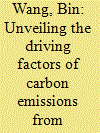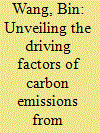|
|
|
Sort Order |
|
|
|
Items / Page
|
|
|
|
|
|
|
| Srl | Item |
| 1 |
ID:
143438


|
|
|
|
|
| Summary/Abstract |
This study uses panel data on the Bohai Rim Region of China to test for spatial autocorrelation, and measures economic spatial spillover effects with the space Durbin econometric model. We discuss whether the economic development of coastal counties benefits the whole area. To do this, we focus on the “distance from the coast” factor, which is influenced by transportation time. The results indicate the presence of significant spatial autocorrelation in the Bohai Rim Region. Further, economic spatial spillover effects exist in this region. “Distance from the coast” exerts a significantly negative impact on the local GDP per capita but a significantly positive impact on the GDP per capita of other districts. This means that the economic development of coastal counties does not benefit the whole region. “Value of exports” exerts a significantly positive influence on the local economy and no significant influence on other counties, while “foreign direct investment” exerts a significantly positive influence on the local economy and a significantly negative influence on other counties. “Number of employees in units” exerts a significantly positive influence on the local economy and a significantly negative influence on the other counties. The factors “primary industry's share in GDP” and “tertiary industry's share in GDP” influence the local economy positively, but the former exerts no significant influence on other counties and the latter exerts a negative influence on other counties. “Rate of fixed asset investment” influences the local economy negatively and has no significant effect on other counties. “Total retail sales of social consumer goods” has no significant influence on the local economy but a positive significant influence on the others. Finally, marine resource utilization and marine output can affect economic growth positively. On this basis, we propose policy suggestions for harmonious economic development in this region.
|
|
|
|
|
|
|
|
|
|
|
|
|
|
|
|
| 2 |
ID:
181466


|
|
|
|
|
| Summary/Abstract |
Analyzing the relationship between industrial resource allocation and carbon emissions from the regional level will promote cross-regional environmental coordinated governance. Based on the panel data of 30 provinces from 2007 to 2016, this paper explores the spatial distribution of industrial resource allocation, spatial autocorrelation of carbon emissions, and the relationship from a spatial econometric perspective. The results show that compared with other provinces, Jilin, Zhejiang, and Guangdong have relatively higher industrial resource allocation efficiency. The provinces with higher carbon emissions are spatially adjacent, and the provinces with lower carbon emissions are also spatially adjacent. On a national level, the improvement of industrial resource allocation can reduce carbon emissions. On a regional level, the impact of industrial resource allocation efficiency on carbon emissions is somewhat different. Industrial resource allocation can significantly reduce carbon emissions in the eastern region. However, it is not clear whether the improvement in the industrial resource allocation efficiency can reduce carbon emissions in the central, western, and northeast regions.
|
|
|
|
|
|
|
|
|
|
|
|
|
|
|
|
| 3 |
ID:
181467


|
|
|
|
|
| Summary/Abstract |
Analyzing the relationship between industrial resource allocation and carbon emissions from the regional level will promote cross-regional environmental coordinated governance. Based on the panel data of 30 provinces from 2007 to 2016, this paper explores the spatial distribution of industrial resource allocation, spatial autocorrelation of carbon emissions, and the relationship from a spatial econometric perspective. The results show that compared with other provinces, Jilin, Zhejiang, and Guangdong have relatively higher industrial resource allocation efficiency. The provinces with higher carbon emissions are spatially adjacent, and the provinces with lower carbon emissions are also spatially adjacent. On a national level, the improvement of industrial resource allocation can reduce carbon emissions. On a regional level, the impact of industrial resource allocation efficiency on carbon emissions is somewhat different. Industrial resource allocation can significantly reduce carbon emissions in the eastern region. However, it is not clear whether the improvement in the industrial resource allocation efficiency can reduce carbon emissions in the central, western, and northeast regions.
|
|
|
|
|
|
|
|
|
|
|
|
|
|
|
|
|
|
|
|
|